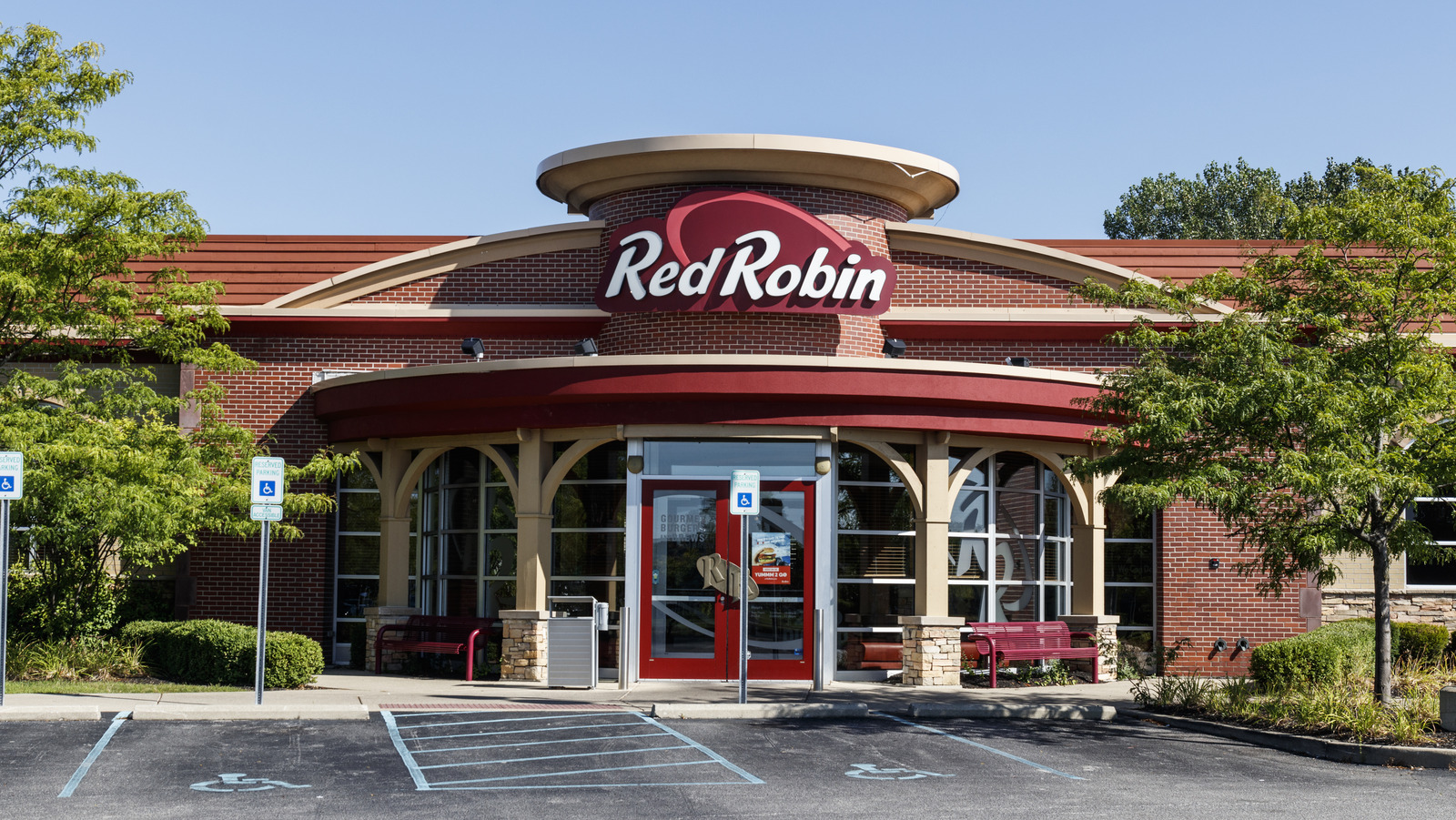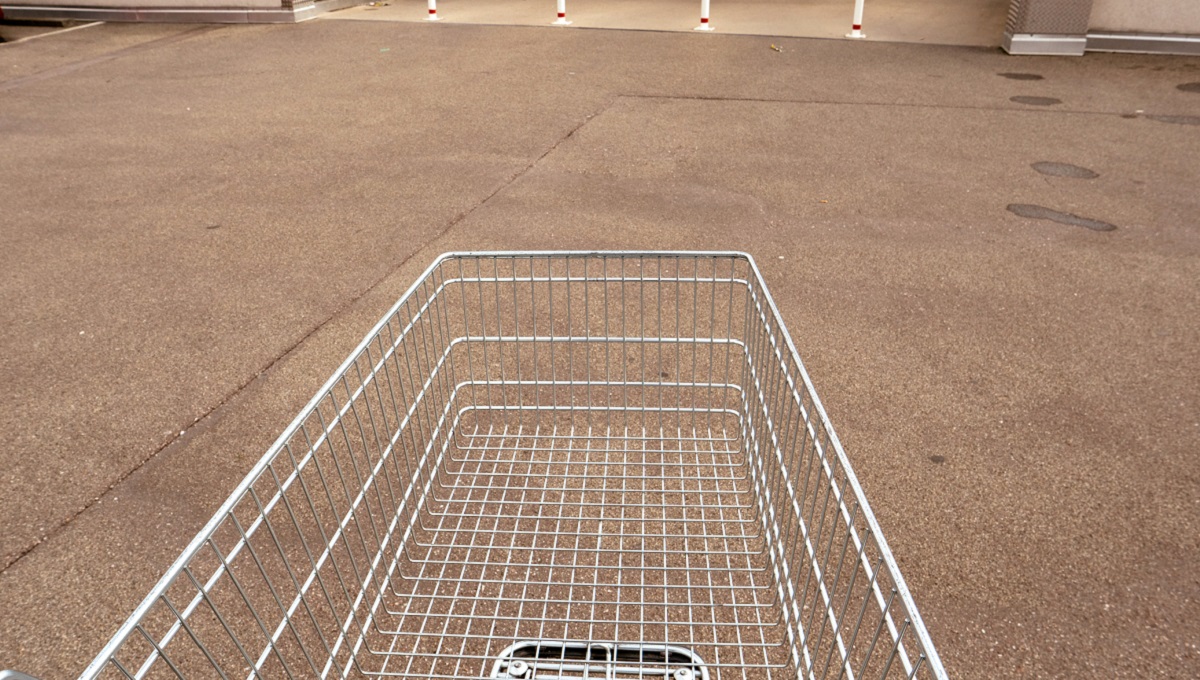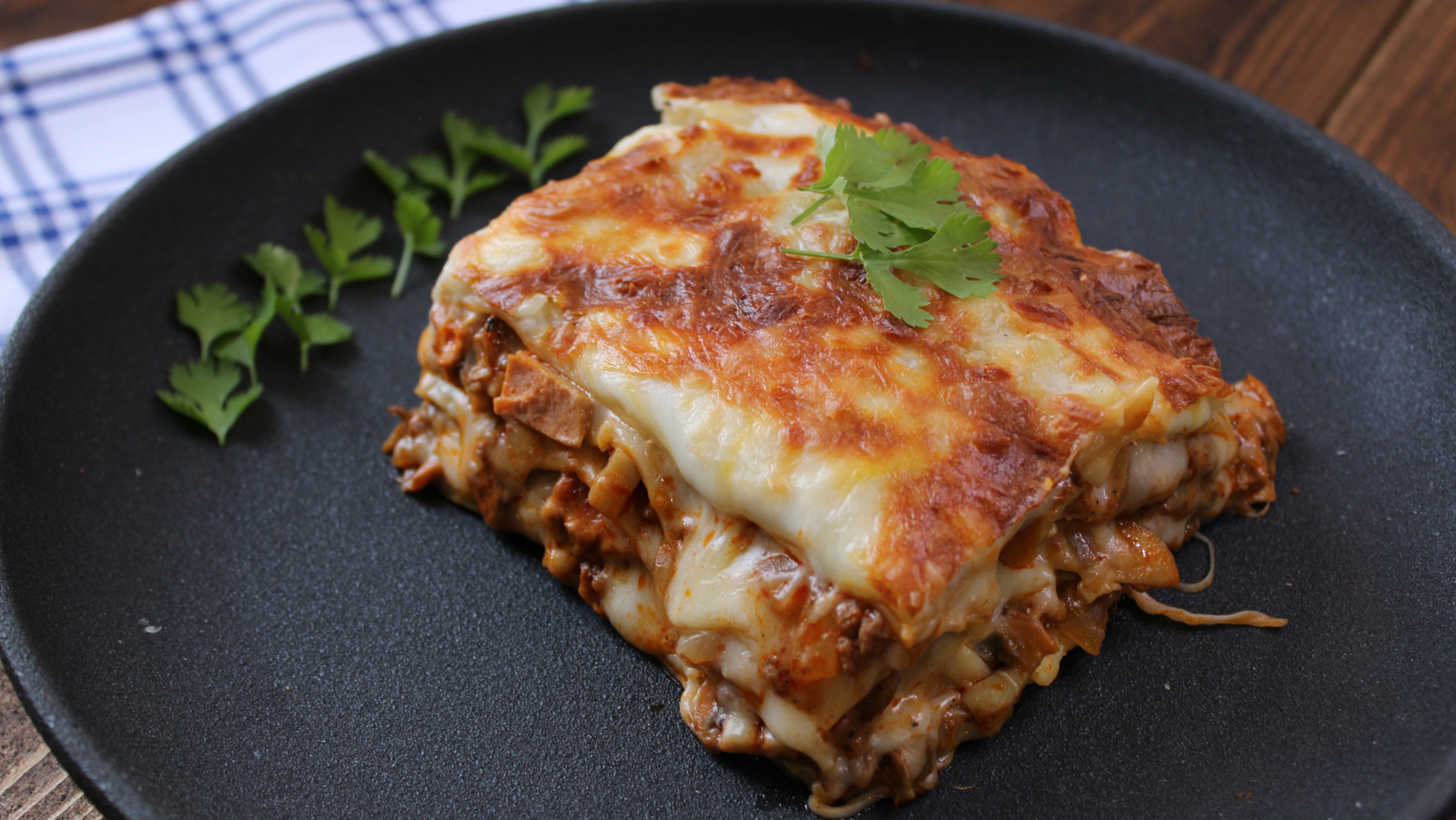
We may not have realized it then, but the closure of Red Robin's first location in 2010 was a harbinger of bad luck for the company. It was just one spot — a tavern-like restaurant in Seattle — but it harkened back to the casual dining chain's humble origins as a university bar. The location served as a focal point for how much the burger restaurant expanded since opening in the 1970s, and losing it was a bit like losing the little red bird's identity.
As laid-back as it may have been, the original spot had character (it had juke boxes and popcorn machines for Pete's sake) — something Red Robin has gradually lost in its transition to just another corporate casual-dining chain. Despite its more standardized look now, Red Robin still managed to worm its way into our collective memory. While it may not be as popular as in its heyday in the early 2000s, who doesn't remember the bottomless steak fries, the gourmet milkshakes, and the classic, resonating, "Yummmm"? We may recall its quirks, but the chain has been steadily losing locations and traffic throughout the last decade, not to mention its special knack for self-destruction.

, and while it's far from the only full-service chain in poor health, the iconic burger restaurant is showing some clear signs of struggle. The restaurant chain is closing locations left and right One of the most apparent signs of a struggling chain is shuttered doors and "permanently closed" labels on Google Maps. In 2025, it was announced that before the end of the decade, with 10 to 15 shutdowns expected within the year.
These weaker locations represent almost 20% of Red Robin's 407 company-owned restaurants. To make matters worse, the announcement came after a solid five-year period of consistent closures. What's clear is that the faltering locations are dragging Red Robin down, amounting to a restaurant-level loss of about $6 million in 2024, and additionally costing the company over $9 million in maintenance and life support.
For a more positive spin on the situation, the burger chain describes these closures as a type of pruning, removing some dead growth and diverting the energy into more productive locations. "We believe the expected closure of a majority of these restaurants will allow the strength of our remaining portfolio to become clear over time and free cash that we expect to reinvest in the business and use to prepay debt," says CEO G.J.
Hart, (via ). No matter how you spin it, however, the closures represent a gradual weakening of the chain. In sharp contrast to the closings, Red Robin has opened only five new locations within the last six years, paired with a trend of declining revenues and same-store sales.
The CMO vanished In early 2025 — around the same time Red Robin announced the closure of dozens of locations — chief marketing officer Kevin Mayer left the company. Another ominous sign for the restaurant's future, Mayer's departure came unexpectedly and with little explanation. While RR has remained tight-lipped, a spokesperson told , "Kevin Mayer has departed Red Robin to pursue other opportunities.
During his tenure, Kevin played a key role leading the marketing team and supporting the North Star plan." After several years of shaky prospects, Red Robin unveiled the North Star plan as a way to revive the chain. Consisting of five points, the plan included long-term strategies like improving guest satisfaction and cutting unnecessary costs.
Mayer played a lead role in executing North Star, even earning himself a place on Nation's Restaurant News Power List for clever campaigns and connecting the brand to a younger audience. His advertisements encompassed everything from a partnership with Juicy Couture (think red velvet tracksuits) to the "Fun Guy" commercials, targeting families and your inner child. Although Mayer's sudden disappearance could come as another hurdle, it ties into Red Robin's larger pattern of unstable upper management.
Within 10 years, the chain has had five different CEOs, some retiring and others leaving unexpectedly. It's no surprise that this constant upheaval coincides with the company's declining revenue and struggling stores. Michael Snyder – one of RR's most successful CEOs — was with the chain in one way or another from 1979 to 2005, for example.
Its stock has been steadily declining In 2015, Red Robin's stock peaked at $92.90 per share. When the price plummeted to $42 in 2018 — following a profit warning — analysts already considered it concerning.
Less than a decade later, its stock is staggering below $5. The self-comparison is alarming enough, but it's also critically low compared to other full-service restaurant chains. The Cheesecake Factory, for example, boasted $50 per share by the end of 2024, while Chili's finished the year at $130.
Although joining the ranks of definitely isn't helping Red Robin's stock, plenty of other factors have spurred its gradual nosedive. The COVID-19 pandemic was detrimental to the restaurant industry, but an already struggling Red Robin had to take on the pandemic with declining sales. Inflation and the rising cost of food have certainly affected the chain, as well as a weary customer base that is more cautious than ever about spending money at restaurants.
And although Red Robin continues to invest in turnaround strategies, its stock fails to make any considerable jumps. Two activist investors have swooped in to inject Red Robin with some cash, including JCP Investment Management and Jumana Capital Partners. The investors have helped other chains in the past — like Applebee's and Jamba — and apparently see hope in the future and North Star revival plan.
With an $8.3 million infusion, the investors expect to take up about 20% stake in the chain's shares. Branching out into fast casual flopped To understand what landed Red Robin in its current predicaments, we have to rewind and look at a series of missteps and misfortunes that have plagued the burger chain.
One of the earlier signs of struggle was in 2011 and the rising tide of fast-casual eateries. In an attempt to compete with the likes of Five Guys, Red Robin introduced Burger Works: smaller units that could seat around 45 customers. The miniature concept could slide into previously uncharted territory for the company, like stadiums and airports.
Opening up in crowded urban locations also allowed Burger Works to engage with the increasing popularity of carryout and delivery. At its height, Burger Works had twelve locations across the U.S.
, five of which were in Chicago. While Red Robin announced its plans to open up to 10 more locations in early 2015, by the following year it was permanently closing almost all of the fast-casual spots. Two of the now-shuttered units had opened just six months earlier.
The three surviving locations would be rebranded into Red Robin Express, a more drastic remodel possibly meant to better stand out from its full-service counterparts. According to a , the cessation of its short-lived Burger Works concept didn't dramatically hurt Red Robin's overall revenue, and figured into a $2.3 million loss from total store closures.
Nevertheless, the failed experiment showed that perhaps Red Robin couldn't fly out of its nest and keep up with ever-evolving consumer interests. The chain eliminated bussers in 2018 By 2018, Red Robin was facing its fair share of struggles. In fact, current CEO G.
J. Hart points to this period as the chain's awakening to some "harsh realities," (via ). He mentions revenue and food quality beginning to diminish, but describes certain labor reductions that decimated guest and employee satisfaction as the most egregious mistakes.
The messy era was marked by management under two separate CEOs — Steve Carley and Denny Marie Post — who effectively slashed or eliminated key positions within restaurants to combat rising minimum wage costs (clearly not the most flattering look for the company). In late 2017, the burger chain got rid of expeditors, and shortly after replaced kitchen managerial roles with more generic back-of-house positions. The most tangible shake-up, however, was the elimination of bussers.
Although the cost-cutting Hail Mary may have initially saved the company millions, it turned out to be little more than self-sabotage. Previously known for their go-getter, personal approach, Red Robin's servers suddenly had double the work load, from running orders to cleaning tables. Dirty and unoccupied tables filled the restaurants during rush hours, increasing wait times and skyrocketing the number of guests that walked away.
Due to the frenzied atmosphere, servers' tips tanked during the busiest hours. Investors quickly saw how the move would upset both staff and clients, and the company's stock sank. Revenue in 2018 followed suit, dropping almost 1%, while same-store sales went down by 2.
6%. A bargain menu item plummeted ticket sales Confronted with dwindling dine-in traffic in 2017, Red Robin needed a way to attract more customers. Then-CEO Steve Carley had the idea to push a promotion — the double Tavern burger menu — which included five burgers priced at $6.
99. Also, the lower-priced burgers may have been an attempt for the full-service restaurant to compete with cheaper options at fast-casual chains. The Tavern burgers weren't even a new menu item, rather Carley just amped up the advertising on an already established deal.
You might think with , the company wouldn't need to promote bargain burgers, but, at first, it seemed like the trick worked. Shortly after giving the promotion a fresh coat of paint, it moved up to 15% of orders, up from 6% two years earlier. However, the brand seems to have a special knack of shooting itself in the foot.
The promotion worked so well that customers stopped ordering other items on the menu, and the average ticket sale went down. Even worse, the Tavern burger didn't attract new clients and repeat customers tended to trade down, opting for the more affordable meal. Overall sales for the company dropped almost $2 million, compared to the same quarter from the previous year.
Once Carley retired, the succeeding CEO Denny Marie Post admitted the deal "went too far," (via ). The chain responded by altering prices on the menu deal and removing some Tavern burgers after introducing new options. Mall locations were already struggling before COVID As food delivery apps became more popular and our social gathering spaces gradually moved online, mall-based restaurants found themselves in a tricky situation.
In 2018, about 16% of Red Robin's 576 locations were in malls, yet they were performing the worst. While these units typically brought in less business, sales dipped 5.5% at mall locations during the last quarter of 2018, compared to about 3% at their non-mall counterparts.
Former CEO Denny Marie Post admitted things looked grim to : "We've seen this get worse three quarters in a row, [and the decline] has us looking with greater urgency at that element of our portfolio." Although Red Robin didn't discard closing some mall-based units, the chain focused on other strategies like rent reduction and increased marketing. Since people tend to spend more when they sit down at a restaurant, the company also introduced dine-in only offers.
All that to say, Red Robin was already in survival mode when the pandemic hit. COVID-19 slashed any chances of boosting traffic to free-standing locations; never mind the malls. It didn't help that the chain had been focusing on pushing dine-in customers, as opposed to delivery or carryout.
By April 2020, the company announced the temporary closure of 35 restaurants. These locations were mostly mall-based that were getting zero traffic due to local mandates. The closures came with pay cuts — including the CEO's — layoffs, and furloughed restaurant workers.
Stiff competition with other burger joints Back in the 1970s, Red Robin looked a lot humbler — and dare we say hipper — than it does today. Located near Seattle's University Bridge, the first Red Robin was more tavern than restaurant, a student hangout with a couple burgers and beers on the menu. Of course, the restaurant has expanded into a nationwide chain, but throughout this "chainification," it perhaps lost some of its original charm.
The truth is, there's no shortage of , and not much that separates one from the other. The toppings can get as wild as you want, but . It's a hard sell, then, to get consumers to sit down at a full-service restaurant for a mere hamburger, especially when they might prefer something locally-owned or more convenient.
Fast-casual chains are on the rise, and reports that burger-minded consumers are leaning toward chains that exude ingenuity and quality. In-N-Out, Culver's, and Shake Shack were some of the biggest names in the burger business in 2023, for example. Not to say that these popular fast-casual chains aren't also quite standardized, but they offer a budget-friendliness and time-efficiency that Red Robin simply can't beat.
RR's wait times seem to be improving, and the menu has its fair share of promotions and deals, but a consumer might still ask, "Why wait at all when I can swing through a drive-thru for something that's just as good?" Employees are fed up When Red Robin eliminated bussers in 2018, it tied into a longer-standing issue between the higher-ups and employees of the chain. The cost-cutting move piled more work onto the servers and increased wait times, completely counterintuitive for the chain that advertises "unbridled generosity" as one of its core principles. "We ensure that our team members are equipped and excited to care for our guests," its reads.
Not long before, in 2015, judges sided with employees in a class action lawsuit over an unfair tipping-out policy. Red Robin had required servers to share their tips with expeditors after a Pennsylvania minimum wage increase, instead of just raising the expos' salaries. Red Robin has since brought back bussers, along with offering managerial incentives and tenured positions.
On paper at least, the improved employee relations has alleviated the adversarial dynamic and drastically improved wait times. Although CEO G.J.
Hart claims that a practice known as "false waits" has diminished, not all employees see it that way. One purported server took to to vent about the "staggered table" tactic at their location. Essentially, guests are seated immediately upon arrival, whether the server is ready or not.
This way, there's technically no wait time, but servers are still getting slammed and customers are still getting impatient, just at their tables. One summed it up in the comments, "Sounds to me like another case of the rules being made by someone who has never done the actual job." The chain is struggling to hold on to customers As restaurant-goers became more budget-conscious in the early 2020s, Red Robin's management realized it had to find ways to meet customers halfway.
Once G.J. Hart took the reins as CEO in 2022, he quickly implemented the North Star comeback plan, in large part to promote Red Robin as a spot for high-quality food and experiences.
"We're screaming 'value' without deep discounting," Hart said in an interview with . Some recent offers include Monster Mondays — upgrade any burger to monster size for $2 — and $10 cheeseburger Tuesdays. These promotions are dine-in only, and lure guests in on typically slower days.
In its quest to stand out against other burger chains, Red Robin is also doubling down on its loyalty program. After signing up, members can immediately redeem a free appetizer, then earn back $10 for every $100 spent. The program comes with a more advanced and personalized guest communications system, and gained about 1.
5 million new members. Despite improved guest satisfaction scores, traffic still fell over 4% in 2024 and estimates show that most loyalty program members are only visiting three to five times a year. In fact, several members went to Reddit to complain about the new rewards system.
"When companies start to mess around with their loyalty programs they quickly fade away," one shared. "I remember days of a packed Red Robin, now it is easy to just walk in on a Friday or Saturday night." Its North Star plan isn't quite hitting the mark With ongoing economic woes plaguing consumers and casual dining chains alike, Red Robin still has an uphill battle to prove that it's thriving, and not just surviving.
The chain has struggled significantly more than its competitors to rebound after the COVID-19 pandemic, and, consequently, has had less resources to pour into its comeback. Its North Star revival plan aimed to amend some of the chain's past slip ups, while hopefully increasing shareholder prospects along the way. The plan strove to distinguish Red Robin from its competitors by getting back to what it does best: hamburgers and hospitality.
New burgers were added to the menu and conveyor belts were swapped out for flat top grills. Bussers, expos, and kitchen managers were brought back into the fold. The goal was to improve quality and give the chain a little more value factor.
Although RR anticipated promising numbers in 2024, North Star has yet to yield significant results. Compared to the previous year, sales in 2024 were lagging by about 1%, total revenue was down over $50 million dollars, and its net loss was up over $50 million. Additionally, locations continue to close.
Addressing the underwhelming results, CEO G.J. Hard said in a , "While financial results for 2024 fell well below our original expectations, we've made substantial improvements to the guest experience and believe we still have a significant opportunity ahead of us to reach the full potential of our iconic brand.
" Recommended.














